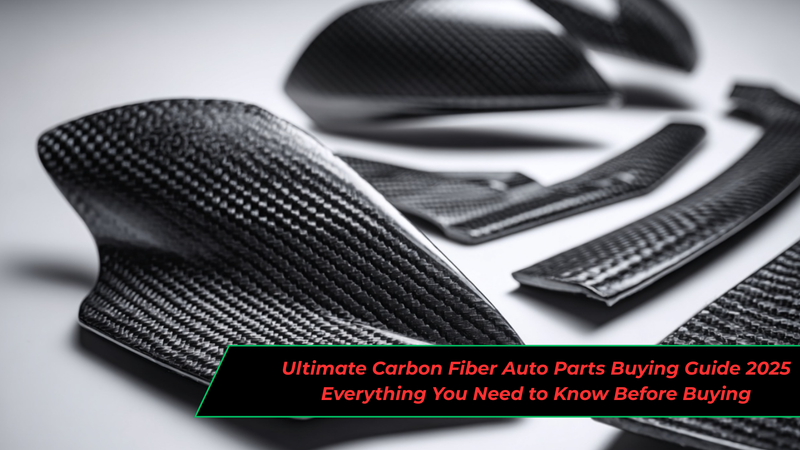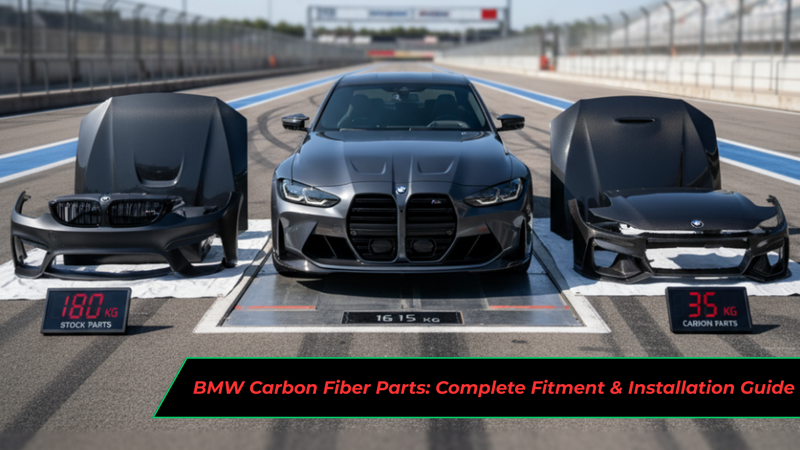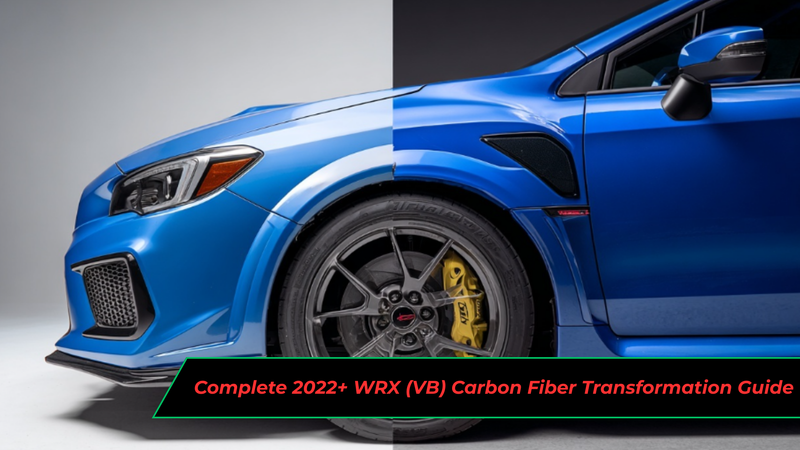
Whether you're looking to shed weight from your track car or add aggressive styling to your daily driver, carbon fiber parts have become the gold standard for automotive enthusiasts. But with prices ranging from $300 mirror caps to $5,000+ body kits, making the wrong choice can be an expensive mistake.

This comprehensive guide breaks down everything you need to know about buying carbon fiber auto parts in 2025, from understanding manufacturing grades to calculating your return on investment. We'll help you avoid common pitfalls and make informed decisions that align with your performance goals and budget.
Understanding Carbon Fiber Grades: Wet-Laid vs Prepreg vs Forged
Not all carbon fiber is created equal. The manufacturing process directly impacts strength, weight, appearance, and price. Understanding these differences is crucial for making informed purchasing decisions.
Manufacturing Process Comparison
| Grade | Process | Strength | Weight | Cost | Best For |
|---|---|---|---|---|---|
| Wet-Laid | Hand-laid resin application | Good (35,000 psi) | Standard | $ | Show cars, interior trim |
| Prepreg | Pre-impregnated resin, autoclave cured | Excellent (50,000+ psi) | 20-30% lighter | $$$ | Track cars, performance |
| Forged Carbon | Chopped fiber compression molding | Very Good (45,000 psi) | 15% lighter | $$$$ | Complex shapes, OEM parts |
| Dry Carbon | Vacuum-infused, autoclave cured | Superior (60,000+ psi) | 40% lighter | $$$$$ | Professional racing |
Wet-Laid Carbon Fiber
The most common and affordable option, wet-laid carbon uses manual resin application. According to Seibon Carbon's manufacturing guide, this process involves laying dry carbon fiber fabric into molds and manually applying epoxy resin. While heavier than premium options, quality wet-laid parts from reputable manufacturers like PSI Carbon's BMW collection offer excellent durability for street use.
Pros:
- Cost-effective (30-50% less than prepreg)
- Readily available
- Suitable for most street applications
- Easier to repair if damaged
Cons:
- Heavier than advanced methods (typically 5-10 lbs for hoods)
- Potential for resin pooling
- Less consistent thickness
- May require clear coat application
Prepreg Carbon Fiber
Prepreg (pre-impregnated) carbon fiber represents the sweet spot for serious enthusiasts. The fabric comes pre-soaked with precisely measured resin, then cured in an autoclave under high pressure and temperature. NitPro Composites' technical analysis shows prepreg achieves 40% better strength-to-weight ratios than wet-laid alternatives.
Pros:
- Optimal resin-to-fiber ratio (35% resin vs 50% in wet-laid)
- Superior surface finish
- Consistent thickness and quality
- Professional racing-grade performance
Cons:
- 2-3x more expensive than wet-laid
- Limited availability
- Requires professional installation for some parts
- Longer lead times (often made-to-order)
Forged Carbon Fiber
Developed by Lamborghini and Callaway Golf, forged carbon uses chopped fiber strands compressed under extreme pressure. While lacking the distinctive weave pattern, it excels in complex geometries where traditional methods struggle.
Pros:
- Exceptional strength in all directions
- Perfect for complex shapes
- No weak points from fiber orientation
- Unique marbled appearance
Cons:
- Most expensive option
- Limited aftermarket availability
- No traditional weave aesthetic
- Difficult to repair
Quality Indicators and Red Flags to Watch For

Visual Quality Markers
When inspecting carbon fiber parts, look for these quality indicators:
High-Quality Signs
✅ Consistent weave pattern - No distortion or waviness
✅ Deep, clear gloss - Mirror-like finish without orange peel
✅ Precise edges - Clean, sealed edges without fraying
✅ Uniform thickness - Consistent depth across the part
✅ Perfect fitment - Test-fitted before shipping
Red Flags to Avoid
❌ Cloudy or milky appearance - Indicates resin problems
❌ Visible air bubbles - Poor vacuum process
❌ Wavy weave patterns - Improper laying technique
❌ Rough or unsealed edges - Cut corners in finishing
❌ Excessive weight - Too much resin content
Weave Pattern Quality
| Weave Type | Appearance | Strength | Typical Use | Price Point |
|---|---|---|---|---|
| 1K | Ultra-fine checkered | Good | Interior trim, mirrors | $$$$$ |
| 2K (3K) | Standard checkered | Excellent | Most automotive parts | $$$ |
| 4K-12K | Large checkered | Good | Budget parts | $$ |
| Plain Weave | Simple over/under | Very Good | Flat panels | $$ |
| Twill Weave | Diagonal pattern | Excellent | Complex curves | $$$ |
According to ShaSha Carbon's weave pattern guide, 2K twill weave offers the best balance of aesthetics, strength, and formability for automotive applications.
Price vs Performance Analysis by Part Type

Understanding the cost-benefit ratio for different carbon fiber parts helps prioritize modifications for maximum impact.
Performance Impact vs Investment Chart
| Part | Weight Savings | Performance Impact | Price Range | ROI Rating |
|---|---|---|---|---|
| Hood | 15-30 lbs | High (handling, acceleration) | $800-2,500 | ⭐⭐⭐⭐⭐ |
| Trunk | 10-20 lbs | Medium (weight distribution) | $700-2,000 | ⭐⭐⭐⭐ |
| Front Lip | 2-5 lbs | Medium (aerodynamics) | $400-1,200 | ⭐⭐⭐ |
| Spoiler | 5-10 lbs | High (downforce) | $500-1,500 | ⭐⭐⭐⭐ |
| Side Skirts | 5-8 lbs | Low (aesthetics) | $600-1,500 | ⭐⭐ |
| Mirror Caps | 0.5-1 lb | None (aesthetics) | $200-500 | ⭐⭐ |
| Diffuser | 3-8 lbs | High (aerodynamics) | $800-2,000 | ⭐⭐⭐⭐ |
| Body Kit | 30-50 lbs | Very High (complete) | $3,000-8,000 | ⭐⭐⭐⭐ |
Weight Reduction Benefits
Every 100 pounds removed equals approximately:
- 0.1 second improvement in 0-60 mph
- 1-2% fuel economy gain
- 3-4% braking distance reduction
- Improved power-to-weight ratio (especially beneficial for turbocharged engines)
For track-focused builds, our carbon fiber hood collection offers the single best weight reduction per dollar spent, with some applications saving over 30 pounds from the highest point of the vehicle.
Choosing Quality Carbon Fiber Manufacturers
Understanding the Carbon Fiber Market
Since carbon fiber parts are typically handmade or produced in small batches, availability and lead times vary significantly. Most reputable manufacturers operate on a made-to-order basis with production times ranging from 2-12 weeks depending on complexity and current demand.
What to Look for in a Manufacturer
Production Quality Indicators:
- Clear photos of actual products (not renderings)
- Detailed manufacturing process information
- Customer reviews with installation photos
- Responsive customer service for fitment questions
- Reasonable lead times (be wary of "always in stock" claims)
Realistic Expectations:
- Most warranties range from 30 days to 1 year
- Fitment often requires minor adjustments
- Custom/handmade nature means slight variations between parts
- Price typically reflects manufacturing method (wet-laid vs prepreg)
According to BMW's official carbon fiber documentation, OEM-grade carbon fiber undergoes extensive testing, but aftermarket parts vary widely in quality standards.
When shopping for carbon fiber parts, ask about the specific manufacturing process, expected lead time, and return policy before ordering.
Installation Complexity Ratings: DIY vs Professional

Not all carbon fiber parts require professional installation. Understanding complexity levels helps budget for total project costs.
Installation Difficulty Matrix
| Part Type | DIY Difficulty | Time Required | Special Tools | Professional Cost |
|---|---|---|---|---|
| Mirror Caps | ⭐ Easy | 30 min | None | $50-100 |
| Interior Trim | ⭐ Easy | 1 hour | Heat gun | $100-200 |
| Front Lip | ⭐⭐ Moderate | 2 hours | Jack, drill | $200-300 |
| Side Skirts | ⭐⭐ Moderate | 3 hours | Jack, drill | $300-400 |
| Spoiler/Wing | ⭐⭐⭐ Moderate | 2-3 hours | Drill, template | $200-400 |
| Hood | ⭐⭐⭐ Moderate | 2 hours | Helper required | $150-250 |
| Diffuser | ⭐⭐⭐⭐ Difficult | 3-4 hours | Lift required | $300-500 |
| Trunk | ⭐⭐⭐⭐ Difficult | 2-3 hours | Wiring skills | $200-350 |
| Full Body Kit | ⭐⭐⭐⭐⭐ Professional | 8-16 hours | Many | $1,500-3,000 |
DIY Installation Tips
- Test fit everything before applying adhesive or drilling
- Use painter's tape to mark drilling locations
- Apply 3M VHB tape for additional security on lips and skirts
- Heat parts gently if minor adjustments needed (max 120°F)
- Have a helper for large parts like hoods and trunks
For detailed installation guidance, check out FlamingHawk's professional installation guide.
ROI Calculator for Weight Savings
Weight Reduction Value Calculator
To determine if carbon fiber parts are worth the investment, use this formula:
Cost per Pound Saved = Part Price ÷ Weight Reduction
Example Calculations:
| Modification | Cost | Weight Saved | $/lb Saved | Performance Value |
|---|---|---|---|---|
| Carbon Hood | $1,500 | 25 lbs | $60/lb | Excellent |
| Carbon Trunk | $1,200 | 18 lbs | $67/lb | Excellent |
| Full Exhaust | $2,000 | 30 lbs | $67/lb | Excellent + Sound |
| Carbon Wheels | $8,000 | 40 lbs | $200/lb | Ultimate (unsprung) |
| Lightweight Battery | $500 | 35 lbs | $14/lb | Best Value |
| Carbon Seats (pair) | $4,000 | 60 lbs | $67/lb | Excellent + Lower CG |
Track Performance Calculator
For every 10 pounds removed:
- Straight-line acceleration: 0.03-0.05 second improvement (0-60)
- Braking distance: 1-2 feet reduction (60-0)
- Lap times: 0.1-0.3 second improvement (2-mile track)
- Tire wear: 2-3% reduction
- Fuel consumption: 0.5-1% improvement
Unsprung vs Sprung Weight
Unsprung weight (wheels, brakes, suspension components) has 3-4x the impact of sprung weight:
- 1 lb unsprung = 3-4 lbs sprung equivalent
- Carbon wheels provide maximum performance gain
- Carbon brake rotors offer both weight and heat management benefits
Maintenance Requirements and Longevity
Proper care ensures your carbon fiber parts maintain their appearance and performance for years.
Maintenance Schedule
| Frequency | Task | Products Needed | Time |
|---|---|---|---|
| Weekly | Rinse/dry | Water, microfiber | 10 min |
| Monthly | Wash | pH-neutral soap | 20 min |
| Quarterly | Deep clean | Detailing clay | 30 min |
| Semi-Annual | Polish | Carbon-specific polish | 45 min |
| Annual | Ceramic coat | Professional grade | 2 hours |
| As Needed | Spot repair | Touch-up kit | Varies |
UV Protection Requirements
According to 3D Car Care's restoration guide, unprotected carbon fiber can begin yellowing within 6-12 months of UV exposure.
Protection Options Comparison:
| Method | Duration | Cost | Protection Level | Appearance |
|---|---|---|---|---|
| Wax | 1-3 months | $ | Basic | Good gloss |
| Sealant | 3-6 months | $$ | Good | Better gloss |
| Ceramic Coating | 1-2 years | $$$ | Excellent | Best gloss |
| PPF (Clear Bra) | 5-10 years | $$$$ | Ultimate | Invisible |
Longevity Expectations
With proper maintenance:
- Wet-laid carbon: 5-8 years before noticeable degradation
- Prepreg carbon: 8-12 years with minimal change
- Forged carbon: 10+ years (most durable)
- Clear-coated parts: Add 2-3 years to base expectation
Frequently Asked Questions (FAQs)

Top 20 Buyer Concerns Addressed
1. Will carbon fiber parts make my car faster?
Weight reduction improves acceleration, braking, and handling. A 50-pound reduction typically yields 0.15-0.2 second improvement in 0-60 times.
2. Do carbon fiber parts crack easily?
Quality carbon fiber is actually stronger than steel. However, unlike metal, it doesn't bend—it fails catastrophically when exceeded. Street use rarely approaches these limits.
3. Can carbon fiber be repaired if damaged?
Yes, minor damage can be repaired with epoxy and refinishing. Major structural damage typically requires replacement.
4. Will carbon fiber parts fit my specific model?
Always verify fitment by year, make, model, and trim level. Our vehicle-specific collections ensure perfect fitment for supported applications.
5. How much weight can I realistically save?
A typical Stage 1 carbon conversion (hood, trunk, spoiler) saves 40-60 pounds. Full builds can reduce weight by 150-200 pounds.
6. Do I need to modify my car for carbon fiber parts?
Most bolt-on parts require no modifications. Some aggressive body kits may need trimming or custom mounting.
7. Will carbon fiber void my warranty?
Exterior modifications typically don't affect warranty. However, check your specific warranty terms and consider Magnuson-Moss Warranty Act protections.
8. What's the difference between real and fake carbon fiber?
Real carbon has depth and shimmer that changes with viewing angle. Fake carbon (hydro-dipped or vinyl) looks flat and uniform. Weight is the definitive test—real carbon is significantly lighter.
9. Do carbon fiber hoods need hood pins?
OEM-style hoods with proper latches don't require pins for street use. Track use or modified latches mandate hood pins for safety.
10. Can I paint carbon fiber parts?
Yes, but it defeats the purpose. If you want painted parts, save money with fiberglass. Some choose partial painting for unique designs.
11. How do I clean carbon fiber?
Use pH-neutral car soap and microfiber towels. Avoid petroleum-based products and harsh chemicals. See our detailed cleaning guide.
12. Will carbon fiber yellow over time?
Unprotected carbon can yellow from UV exposure. Quality parts with UV-stable clear coat and regular maintenance prevent yellowing.
13. Are carbon fiber parts legal for street use?
Most cosmetic parts are legal. Some states restrict hood modifications affecting visibility. Check local regulations for specific requirements.
14. What tools do I need for installation?
Basic hand tools for most parts. Specialized needs include: heat gun (trim), drill (lips/spoilers), jack/stands (underbody parts).
15. Should I buy wet-laid or prepreg carbon?
Wet-laid suits most street applications and budgets. Prepreg justifies the premium for serious track use or when maximum weight savings matter.
16. How can I verify carbon fiber authenticity?
Request manufacturing details, check weight specifications, examine weave consistency, and buy from reputable sources with return policies.
17. Do carbon fiber parts affect insurance?
Modifications should be declared to insurance. Some companies increase premiums; others offer agreed-value policies for modified vehicles.
18. Can carbon fiber withstand winter conditions?
Yes, carbon fiber handles temperature extremes better than most plastics. Use appropriate winter car care practices and avoid impact from ice chunks.
19. What's the resale value of carbon fiber parts?
Quality parts retain 50-70% of value if well-maintained. Popular applications (BMW M, Subaru WRX) have strong secondary markets.
20. Where should I start with carbon fiber modifications?
Begin with high-impact parts: hood for weight reduction, front lip for aesthetics, or mirror caps for affordable entry. Build gradually based on goals.
Conclusion: Making Smart Carbon Fiber Investments
Investing in carbon fiber parts requires balancing performance goals, aesthetic preferences, and budget constraints. Focus on high-impact modifications first—a quality carbon fiber hood delivers more value than scattered small parts.
Remember these key principles:
- Buy once, cry once: Quality parts last longer and perform better
- Verify fitment: Measure twice, order once
- Plan your build: Cohesive modifications look and perform better
- Maintain properly: Protection preserves your investment
- Know your goals: Track performance vs street style drives different choices
Whether you're chasing lap times or perfecting your show car, understanding carbon fiber grades, quality indicators, and maintenance requirements ensures you make informed decisions that deliver lasting satisfaction.
Ready to start your carbon fiber transformation? Browse our complete collection of premium carbon fiber parts with guaranteed fitment and industry-leading warranty protection.
Have questions? Contact our carbon fiber specialists at support@psicarbon.com



